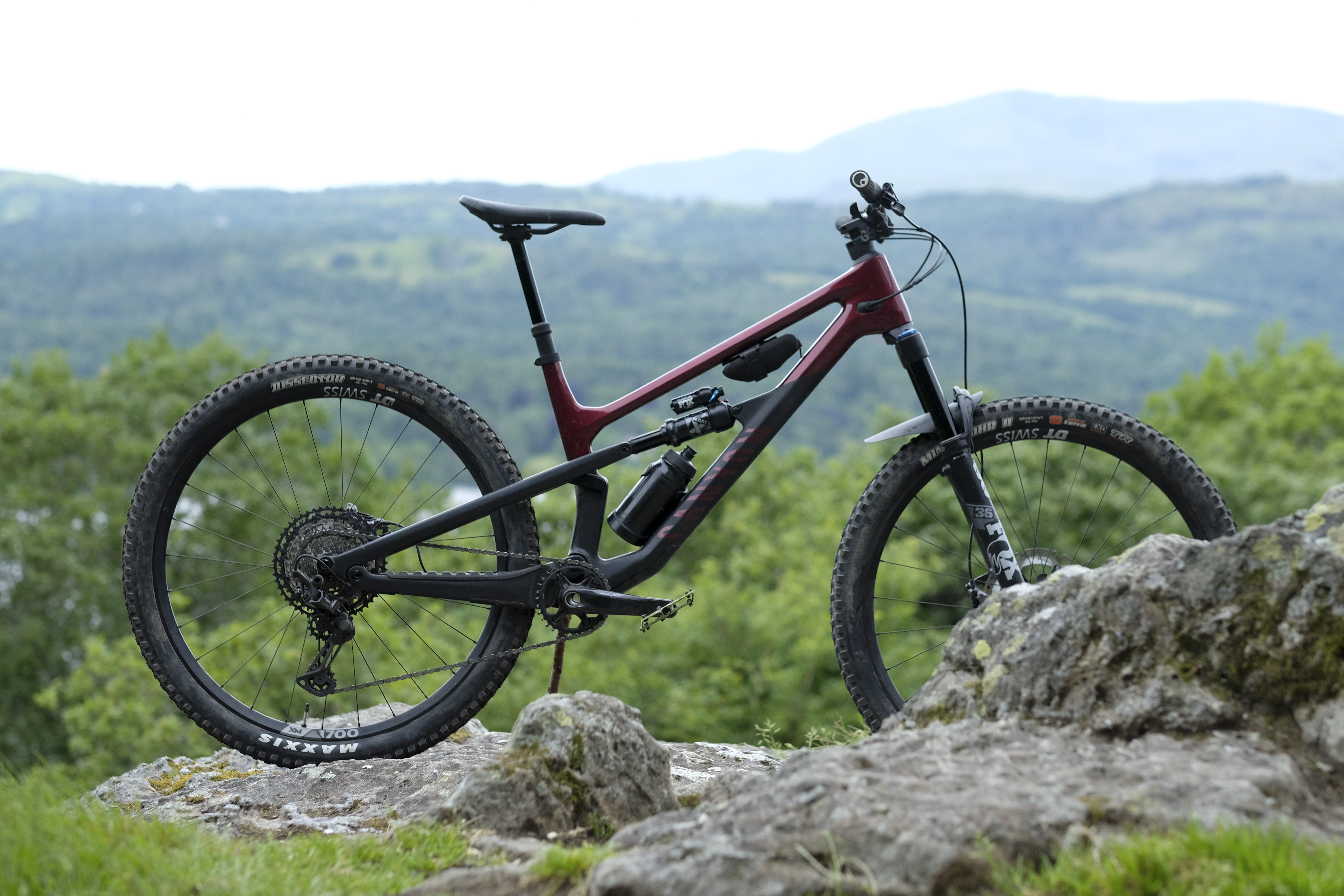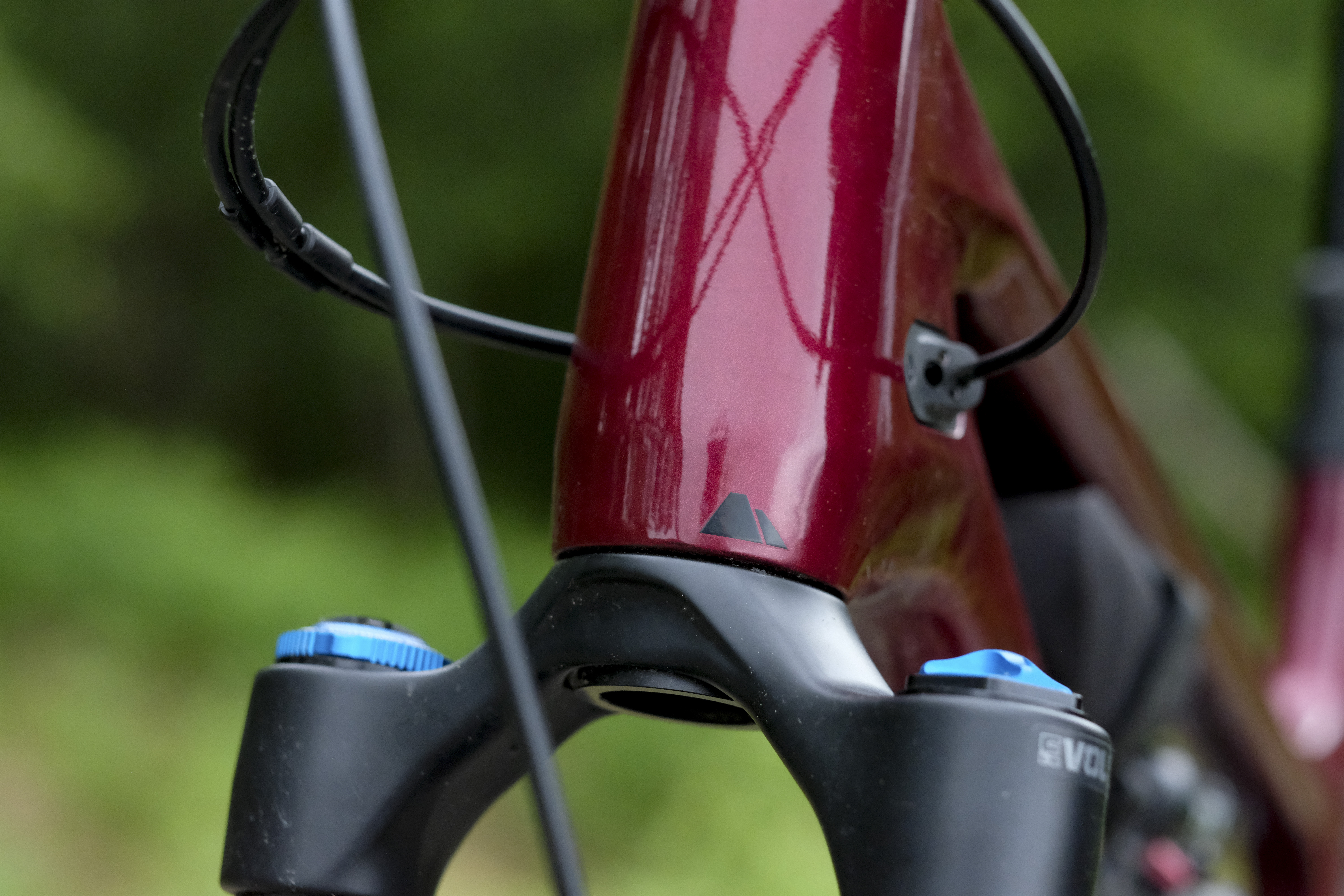The new-for-2022 Canyon Spectral 125 has pretty much the exact same geometry as the regular 150mm rear-travel Spectral – it’s arguably ‘radder’ in some of its numbers – but, as the name suggests, it only has 125mm of rear travel. Why?
- Price: £4,399
- From: canyon.com
- Tested by: Benji and Ross

Offering less travel is not really about saving any weight. This is not a down-country project. None of the Spectral 125 builds are very different in weight to the 150mm Spectrals. The Spectral 125 is essentially about a different feel. A different ride experience. Without wishing to give too much of the game away this early in the review, the Spectral 125 is an insanely firm mountain bike.
The Spectral 125 is an absolute outlier. Not only in the general mountain bike market, but also within Canyon. Canyon doesn’t typically do oddball bikes. Canyon makes race-proven, racer-promoted mountain bikes with mass appeal. This is something else – a playbike – which Canyon describes as a bike which “can get wild with the best of them, yet has enough agility to turn even the mellowest trails into its playground”.
Just WTF is Canyon thinking with the Spectral 125? And who the heck is going to agree with them?




The Bike
One thing that is still very Canyon is the aesthetic and quality of construction of the Spectral 125. It looks very much like a Canyon. It is impressively put together. The whole package exudes quality and a design that’s been well thought through.
As mentioned, the rear travel is 125mm. The fork gets a bit more beef, but it’s still a modest 140mm travel Fox 36. To get nerdy for a moment, the suspension kinematic is not quite the same sort of vibe as the longer travel Spectral. Canyon mountain bikes are generally very firm around the sag point with high anti-squat values, and the Spectral 125 takes this to another level. The Spectral 125 begins firm, remains firm and ends very firm. We can’t be alone in thinking that the Spectral 125 is Canyon’s response to the YT Izzo range of bikes. The Izzo may have a similar-ish amount of suspension travel and even a similar attitude to anti-squat values, but the geometries are chalk and cheese.
What geometry numbers are we talking about here anyway? Head angle 64°, seat angle 76°, 486mm reach (Large) and the biggest dropper post you can possibly squeeze in there please (200mm on Large or Extra Large). The carbon Spectral 125 bikes come with a flip chip, but it’s a bit redundant as it doesn’t change the angles very much and the low BB setting is not massively low. The Spectral 125 uses double-sealed bearings and gets replaceable alloy thread inserts at all pivots. There’s also full internal cable routing.
The 140mm fork takes this bike out of the down-country ghetto, but is it a trail bike? Canyon claims that the bike has two demographics: experienced riders who prefer snappy handling bikes, and riders who live in terrain that doesn’t ‘need’ decent amounts of suspension travel. One of the reasons the Spectral 125 isn’t significantly lighter than the regular Spectral is that it’s still made to Canyon’s Category 4 strength rating. This is the same rating as their EWS-tastic Strive bikes. You don’t have to worry about smashing the Spectral 125 down whatever madness you wish.
The Spectral 125 is a timely reminder that the amount of travel is no longer the be-all and end-all. There can be stiff 160mm ‘rally car’ bikes and soggy 100mm ‘comfy’ bikes. The Spectral 125 is not more efficient because it has less travel than regular trail bikes. It’s more efficient because it has more anti-squat and a firmer mid-stroke and progressive ramp up at the end.
Despite any other pretensions they might like to aspire to, direct sales brands like Canyon live or die by their spec. If the spec’s not good, no one’s ordering a mail-order mountain bike. This bike has a great spec where it counts. It saves a bit of money, but loses little in the way of style (and zero in the way of function) by fitting an own-brand stem, handlebars and dropper seatpost. The latter of which is operated by the lesser-spotted, but totally excellent Shimano dropper remote.
Going through the bike’s build kit there are plenty of highlights. The fork is great. The brakes are brilliant (because they’ve been properly pre-bled). The tyres are great all-rounders from Maxxis. Even the Ergon grips are ace. The solitary niggle was the saddle. It was a bit on the overly firm side (which does sorta suit the bike’s vibe, but still…).


The Ride
We need to come out and state something important. Not many people will like or suit this bike. It is in no way a failing of the bike’s designers. We think that the Canyon Spectral 125 is exactly what the Spectral 125 designers want it to be.
Yes, it’s a swish carbon bike with super progressive geometry, but it has much more in common with a fully rigid steel singlespeed than a modern full-suspension trail bike. It feels like it has very little in the way of the increased traction or comfort that you’d typically expect from a full suspension bike. But then you look down at your O-rings at the end of a descent and you can see that you’ve used all of the travel.
It is not a relaxing ride. It’s not even a confidence inspiring ride in the traditional sense. You absolutely have to be totally on it when riding the Spectral 125.
Where the Specialized Stumpjumper Evo Alloy is Derek Ringer (rally car co-pilot legend) and the Pace RC295 is Adrian Carter, the Canyon Spectral 125 is Joe Pesci. It’s all a great laugh until it says “Funny how?” and throws a Lakeland water bar at you at 20mph. If you’re having a good day, and you’re only out for a couple of hours or so, the Spectral 125 offers an exhilarating experience that is arguably unachievable on any other bike we can think of (it kind of reminded us of the Kona Process 111 cult bike from a few years ago actually).
There might be ways to loosen up the Spectral 125’s taut edginess. We did try running stoopid amounts of sag while setting the flip chip to HI setting to offset the low-rider pedal-clouting. We did run beefier casing tyres too. But we couldn’t help thinking that such things were just trying to turn it into a bike that it isn’t. Let the Spectral 125 be what it is.
On days when you’re not quite feeling it, or (more importantly) during longer rides, the Spectral 125 is just that tad too stiff. Not just in suspension progressivity, but also in chassis feel. It feels like an off-road BMX at times. Super accurate, but similarly intolerant of less than perfect inputs from the pilot and rather wrist/ankle unfriendly.
The Spectral 125 appeals to the rider who prizes sensation over velocity. Someone who rides the same stupid stuff as the Super Enduro Brigade, but appears at the bottom a couple of minutes later, having worked harder, and consequently having had a more rewarding experience, arguably.
Intriguingly, the Spectral 125’s impressive standover numbers kind of reverse the oft-stated mantra of upsizing (opting to get a bigger frame size than is your normal). The seat tube lengths are relatively short on all sizes, which also opens up the potential for seasoned/bored enduro riders downsizing to get a bike that is less planted at speed, but more pick-up and play-able at slow and middling speeds. We really think downsizing (or at least not upsizing) is a key thing with the Spectral 125. It simply doesn’t have the suspension travel to hurtle at high speeds down proper mountain bike terrain that super-long wheelbase bikes are fun on.
If you’re embracing modest millimetres of suspension you should be accepting of similarly modest millimetres of wheelbase. Being able to get your bike off the ground instantly will very likely save your neck (and rims) on numerous occasions.
Not to mention, it’s just fun.

Overall
The Canyon Spectral 125 has a modest amount of travel and rides like it has even less. Again, not a criticism. It’s an observation. It’s confirmation of what Canyon wanted with this bike.
Out on the trails, it feels more like a 120/100mm travel bike that’s paired with geometry to get down – and up, and along – anything you care to show it. And its relative heft, while not really felt on climbs due to the efficient propulsion of the bike, stops the Spectral 125 from being skittish or knocked off line as easily as a genuine 120/100mm bike.
It may well leave you feeling a bit more worked-over after a big day out in big terrain but… how often do you actually do those days? If your riding is technically demanding, but more in relatively short bursts rather than an extended way, you’ll like what the Spectral 125 offers.
Canyon Spectral 125 CF 8 Specification
- Frame // Carbon Fibre, 125mm
- Shock // Fox Float X Performance, 210x50mm
- Fork // Fox 36 Performance Elite GRIP2, 140mm
- Wheels // DT Swiss XM1700
- Front Tyre // Maxxis Minion DHR II MaxxTerra EXO 29×2.4
- Rear Tyre // Maxxis Dissector MaxxTerra EXO 29×2.4
- Chainset // Shimano XT
- Drivetrain // Shimano XT
- Brakes // Shimano XT M8120, 203/180mm rotors
- Stem // G5
- Bars // G5 AL
- Grips // Ergon
- Seatpost // G5 Dropper 200mm
- Saddle // Ergon SM10 Enduro Comp
- BB // Shimano
- Size Tested // L
- Sizes Available // S, M, L, XL
- Weight // 14.33kg
Geometry For Our Size L Test Bike
- Head angle // 64.08°
- Effective seat angle // 76°
- Seat tube length // 435mm
- Head tube length // 130mm
- Chainstay // 437mm
- Wheelbase // 1,259mm
- Effective top tube // 636mm
- BB height // 35mm BB Drop
- Reach // 486mm]






